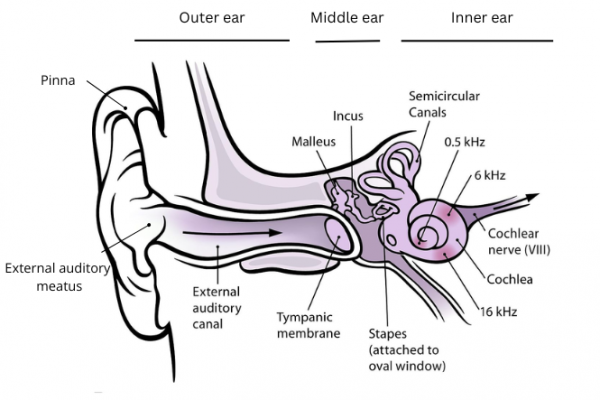Wishing everyone a safe and happy Christmas and New Year – Meri Kirihimete from the Healthify team.
Ear infection – outer ear | Pokenga taringa
Also known as otitis externa and swimmer's ear
Key points about otitis externa (outer ear infection)
- Otitis externa (pokenga taringa) is inflammation or infection affecting the outer part of your ear and the ear canal which runs from your outer ear to your eardrum.
- It causes pain, itchiness and swelling
- It's different to otitis media, which affects your middle ear behind your eardrum.
- It's often seen in swimmers or people whose ears are wet a lot of the time.
- Treatment includes keeping your ear dry and using ear drops.

Otitis means inflammation of your ear, externa is the outside or external part of your ear. That includes the pinna, the part on the outside of your head which you can grab, the meatus or opening into your ear, and the ear canal or tube which is lined with skin and leads in to your ear drum.
These parts of your ear can get infected by bacteria and fungi. They can also get inflamed by skin conditions (eg, eczema) or by allergens (eg, hair dyes). This causes the symptoms of otitis externa.

Image credit: Chittka L, Brockmann(external link) Wikimedia Commons with added labels
The most common cause of outer ear inflammation is an infection caused by bacteria, or less often, fungus. It can also be caused by something other than an infection.
Your risk of getting otitis externa is increased if:
- Your ears are often wet: Dampness creates an ideal environment for bacteria and fungi to grow and makes your ears more prone to infection.
- Skin damage: This could be from scratching, cleaning with cotton buds, or using ear buds, in-ear headphones or a hearing aid.
- Use of chemicals: These are found in products including shampoo, conditioners, hair spray and hair dye that can irritate your ears, making them more prone to infection.
- Skin or allergic conditions: For example dermatitis, psoriasis, eczema, acne, asthma or hay fever.
- Narrow ear canals: This stops water draining away easily.
- A health condition that affects your ability to fight infection: For example, diabetes or HIV or if you 're undergoing certain treatments (eg, chemotherapy).
- Infection of a hair follicle in your ear canal: This can cause a pimple or boil.
- Discharge from middle ear infections: Sometimes infections of the inner ear can produce a pussy discharge that gets stuck in the ear canal and this can cause an outer ear infection.
The video below talks about otitis externa caused by infections.
Video: Swimmer's ear – quick facts
Often only 1 ear is affected. Symptoms affecting your ear and surrounding area include:
- ear pain or pain when moving your ear or jaw
- itchiness and irritation in or around your ear canal
- swelling and redness of your ear canal and surrounding area
- peeling skin inside and around your ear
- fluid from your ear, often with a bad smell – this may be the only symptom if you have a fungal infection.
A very rare but dangerous complication is malignant otitis externa. This is the spread of infection to the bones of your ear canal and lower part of your skull. If you have an outer ear infection and experience strange symptoms (eg, dizziness or muscular weakness in your face) seek immediate medical help.
Your healthcare provider will ask you about your symptoms and examine your ear. If your symptoms keep returning, then a swab (using a sterile cotton wool bud) from your ear will be taken and sent to the laboratory for testing.
- Try to keep the affected ear dry.
-
- Wear a shower cap while showering and avoid swimming until your symptoms have fully cleared.
- If water gets into your ears, turn your head to the side and pull your earlobe in different directions to help the water drain out.
- Gently clean any discharge from the outer ear with cotton wool. Don't put anything into your ear canal. Cotton buds can put a hole in your ear drum and leave behind fluff which can make thing worse.
- Remove anything from the ear that may cause irritation, eg, earrings or hearing aids.
- Take pain relief such as paracetamol or ibuprofen if they're safe for you to take.
- Acetic Acid 2% drops (eg, Audisol Dry Ears®) are effective for mild otitis externa. These can be bought over the counter from your pharmacy. If you use them for 10 days and they're not working, make an appointment to see your healthcare provider.
- If a boil is the cause, holding a warm cloth over the affected ear can provide relief.
Ear candles don't help otitis externa and are not recommended for treatment as they may cause more injury to your ears.
Your healthcare provider will clean your ear, recommend you follow self-care measures and prescribe ear drops.
Otitis externa can get better without ear drops, but this may take weeks. Ear drops can help speed up the healing process. They're used because they work better for most otitis externa than medicines taken by mouth (orally). Ear drops usually need to be used several times a day for about a week.
To treat a mild outer ear infection, you can get ear drops from your pharmacy, eg, Vosol®. Other ear drops need to be prescribed, these include:
- ear drops that contain antibiotics to treat infection, eg, Soframycin®
- antibiotic ear drops combined with a steroid to reduce the inflammation (swelling) associated with the ear infection, eg, Ciproxin HC®, Sofradex®, Locacorten-Vioform® and Kenacomb®.
Read more about ear drops, including how to put them in so that they work well.
Further treatment depends on the severity and cause of the infection or inflammation. Treatments for skin conditions (eg, dermatitis, psoriasis or eczema) may be prescribed. You may need to be referred to a specialist ear nurse for suction of ear discharge or to an ear, nose and throat (ENT) specialist.
It's not always possible to prevent an outer ear infection or inflammation, but there are things you can do to reduce your risk of developing the condition.
- Dry your ears thoroughly with a towel to remove water, sweat or moisture. Use a hair dryer on low to gently dry your ear canal. Don’t use the corner of a towel.
- Avoid damaging your ears by not putting anything inside your ear canal, including cotton wool buds.
- If you swim regularly, use a swimming cap that covers your ears or use earplugs (inserted gently to avoid damage) to help prevent water getting into your ears.
- Give your ears a rest from ear devices (eg, earplugs, hearing aids and in-ear headphones).
- Treat and prevent other conditions that may be triggering otitis externa. These include allergies, dermatitis, psoriasis and eczema.
Otitis externa(external link) DermNet, NZ
Apps
References
- Swimmer's ear(external link) Better Health Channel, Australia, 2014
- Otitis externa(external link) Patient Info, UK, 2024
- Otitis externa(external link) DermNet New Zealand, NZ, 2024
- Otitis externa(external link) Auckland Region HealthPathways, NZ, 2020
Credits: Healthify editorial team. Healthify is brought to you by Health Navigator Charitable Trust.
Reviewed by: Dr Emma Dunning, Clinical Editor and Advisor
Last reviewed:





